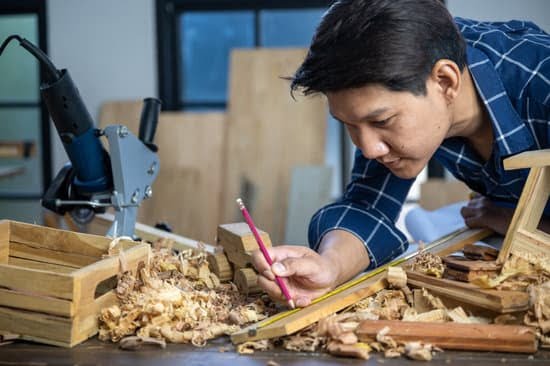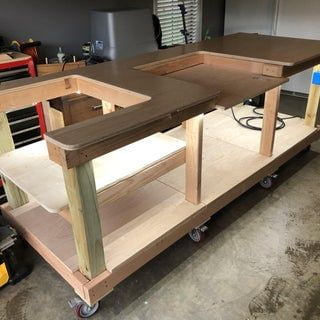Have you ever wondered how hard it is to learn woodworking? Whether you’re drawn to the idea of creating beautiful, functional pieces of furniture or simply enjoy the process of working with your hands, woodworking offers a unique and rewarding experience.
The appeal of woodworking lies in its ability to blend creativity with practical skill, making it a popular hobby for many individuals. In this article, we will explore the journey of learning woodworking, from understanding the basics to finding inspiration for your projects.
Woodworking encompasses a wide range of skills and techniques, which can be intimidating for beginners. However, with the right guidance and resources, learning woodworking can be an accessible and fulfilling endeavor. This introductory section will delve into the reasons why people are drawn to woodworking and why they desire to learn this timeless craft. By understanding the motivation behind learning woodworking, you can gain insight into what drives individuals to embark on this creative and challenging journey.
From selecting the right type of wood to mastering essential tools and safety precautions, discovering the fundamentals is crucial for anyone interested in pursuing woodworking. As we explore the various aspects of acquiring knowledge in this craft, we’ll discuss the importance of patience and consistent practice in honing your skills.
Whether you’re looking to build your own workbench or create intricate carvings, mastering woodworking requires dedication and a willingness to embrace both challenges and mistakes along the way. Join us as we embark on this journey into the world of woodworking.
The Basics
Woodworking is a skill that requires a solid understanding of the different types of wood, tools, and safety precautions. Many beginners may wonder, “How hard is it to learn woodworking?” The truth is that while woodworking does require patience and practice, it is certainly achievable with the right knowledge and guidance.
When it comes to the different types of wood, it’s essential to familiarize oneself with both hardwoods and softwoods. Hardwoods such as oak, maple, and cherry are known for their durability and strength, making them suitable for furniture making. On the other hand, softwoods like pine and cedar are often used for building construction due to their abundance and affordability.
In addition to understanding wood types, beginners must also learn about the various tools used in woodworking. Basic tools include saws, chisels, hammers, drills, and measuring instruments. As skills progress, individuals may also venture into more advanced power tools such as routers and sanders. Understanding how each tool functions and how to use them safely is crucial in woodworking.
Lastly, safety precautions cannot be overstated when it comes to woodworking. Proper eye protection, hearing protection, dust masks, and knowing how to handle tools safely are all essential components of woodworking safety. By taking the time to understand these basics thoroughly before diving into projects, beginners can set themselves up for success in their woodworking journey.
| Wood Type | Examples |
|---|---|
| Hardwoods | Oak, Maple |
| Softwoods | Pine, Cedar |
Getting Started
When it comes to learning woodworking, one of the first steps is to set up a suitable workspace and acquire the necessary equipment. Many beginners may wonder how hard it is to learn woodworking, but with the right approach and dedication, it is certainly achievable. The key is to start with the basics and gradually build up your skills and knowledge.
Setting up a woodworking space involves finding an area that allows for ample room to maneuver and work comfortably. It’s important to have good lighting, ventilation, and a sturdy work surface. Additionally, having storage for tools and materials is essential for keeping your space organized.
As for acquiring necessary equipment, beginners should invest in essential hand tools such as chisels, saws, planes, measuring tools, and clamps. As skills develop, power tools like a table saw, jigsaw, drill press, and power sander can be added to the arsenal. Safety equipment such as goggles, ear protection, and respiratory masks should also be prioritized to ensure safe working conditions.
One useful strategy for those just starting out in woodworking is to seek guidance from experienced woodworkers or take classes at local woodworking schools or community centers. Online tutorials and books are also valuable resources for learning about different techniques and projects. With the right setup and equipment in place, beginners will be well on their way to learning the art of woodworking.
| Woodworking Space | Necessary Equipment |
|---|---|
| Ample room for maneuvering | Essential hand tools (chisels, saws) |
| Good lighting and ventilation | Safety equipment (goggles, ear protection) |
| Sturdy work surface | Power tools (table saw, drill press) |
Learning Resources
When it comes to learning woodworking, there are a variety of resources available for beginners to explore. Whether you prefer hands-on learning in a classroom setting or the flexibility of online tutorials, there are options to suit every learning style and schedule.
Woodworking Classes
For those who thrive in a structured learning environment, taking woodworking classes can be an excellent way to gain hands-on experience and guidance from experienced instructors. Many local community centers, vocational schools, and woodworking shops offer classes tailored to beginners. These classes often cover topics such as tool usage, safety precautions, basic techniques, and project construction.
Books and Manuals
For individuals who prefer self-guided study, woodworking books and manuals can provide a wealth of information on everything from wood selection and tool usage to joinery techniques and project plans. There are countless titles available on the market catering to both beginner and advanced woodworkers. Many of these resources include step-by-step instructions accompanied by detailed illustrations or photographs.
Online Tutorials
In today’s digital age, online tutorials have become an increasingly popular avenue for learning woodworking. Websites like YouTube offer a vast array of instructional videos that cover topics ranging from simple DIY projects to more complex furniture-making processes. Additionally, there are many websites dedicated exclusively to providing comprehensive courses in woodworking for all skill levels.
Exploring these different options for learning woodworking can help individuals determine which method best suits their needs and goals. No matter which resource is chosen, remember that consistent practice is key in mastering this craft.
Skill Building
When it comes to learning woodworking, there are several fundamental techniques and skills that are essential for excelling in this craft. Whether you’re a beginner or have some experience, mastering these skills is crucial for creating high-quality and professional-looking wood creations. Here are the key techniques and skills you’ll need to develop:
1. Measurement and Cutting: Accurate measurement and precise cutting are vital in woodworking. Understanding how to properly measure and cut wood materials will ensure that your projects come together seamlessly without any misalignments or uneven edges.
2. Joinery: Joinery refers to the methods used to connect wood pieces together, such as using dovetail joints, mortise and tenon joints, or simple butt joints. Mastering various joinery techniques is essential for creating strong and durable woodwork pieces.
3. Wood Finishing: Learning how to properly finish wood surfaces is crucial for enhancing the visual appeal of your projects. This includes sanding, staining, sealing, and applying a protective finish to create a smooth and beautiful end result.
4. Tool Handling: Proficiency in using woodworking tools such as chisels, planes, saws, and routers is essential for executing precise cuts and shapes in your projects while ensuring safety at all times.
5. Design and Planning: Being able to design and plan out your woodworking projects effectively is a skill that can greatly impact the outcome of your work. Understanding how to conceptualize ideas, create detailed plans, and troubleshoot potential issues will set you up for success in your woodworking endeavors.
Learning these fundamental techniques may seem daunting at first, but with patience, practice, and dedication, mastering these skills is entirely achievable no matter what level of experience you have. As you continue honing these abilities through consistent practice, you’ll find yourself becoming more confident in tackling increasingly complex woodworking projects.
Mistakes and Challenges
Learning woodworking can be an incredibly rewarding and fulfilling experience, but it’s important to acknowledge that it also comes with its fair share of challenges. As a beginner, it’s normal to make mistakes and encounter obstacles along the way. Understanding these common pitfalls and knowing how to address them can help you navigate the learning process more effectively.
Here are some of the most common mistakes and challenges that beginners may encounter when learning woodworking:
1. Lack of proper safety precautions: One of the most important aspects of woodworking is safety. Not wearing the necessary protective gear, using tools incorrectly, or not following safety guidelines can lead to accidents and injuries. It’s crucial for beginners to prioritize safety at all times when working with wood.
2. Choosing the wrong type of wood: Different types of wood have different properties and are suitable for different projects. Using the wrong type of wood for a project can result in a finished product that is not structurally sound or does not meet your expectations.
3. Inaccurate measurements and cuts: Precision is key in woodworking, and inaccurate measurements or cuts can ruin a project. It’s essential for beginners to take their time and double-check their measurements before making any cuts.
By being aware of these common mistakes and challenges, beginners can be better prepared to tackle them head-on as they continue on their woodworking journey. By taking the time to learn from these obstacles, they will ultimately become more skilled and confident in their abilities as woodworkers.
Patience and Practice
Learning woodworking requires a significant amount of patience and consistent practice in order to master the craft. While it can be challenging at times, the rewards of creating beautiful and functional pieces with your own hands are well worth the effort. In this section, we will explore the importance of patience and practice in woodworking, as well as provide some tips for staying motivated in your learning journey.
Importance of Patience
Patience is crucial in woodworking, as it is a meticulous and detail-oriented craft. From carefully measuring and cutting wood to meticulously sanding and finishing a project, each step requires careful attention and a steady hand. It’s important to remember that Rome wasn’t built in a day, and neither are expert woodworking skills. Developing patience will allow you to focus on the quality of your work rather than rushing through tasks.
Consistent Practice
Consistent practice is key to improving your woodworking skills. Just like any other skill, woodworking takes time to develop, and the only way to get better is by practicing regularly. Whether it’s honing your sawing techniques or perfecting your joinery skills, dedicating regular time to working on projects will help you build confidence and proficiency in the craft.
Staying Motivated
One of the biggest challenges in mastering woodworking is staying motivated, especially when mistakes occur or when progress feels slow. Surrounding yourself with a supportive community of fellow woodworkers can provide encouragement, inspiration, and valuable advice. Additionally, setting achievable goals for each project can help you stay focused and maintain momentum in your learning journey. Remember that every mistake is an opportunity to learn and grow as a woodworker.
By embracing patience, committing to consistent practice, and finding sources of motivation, learning woodworking becomes an enjoyable and fulfilling experience. The more time and effort you invest in honing your skills, the more rewarding it becomes to see your progress unfold through beautifully crafted pieces. So keep at it – with determination and perseverance, you’ll soon find yourself mastering the art of woodworking.
Finding Inspiration
In conclusion, learning woodworking is an art that requires dedication, patience, and a willingness to learn. As discussed in the previous sections, understanding the basics of woodworking, setting up a workspace, and acquiring necessary tools are essential steps to getting started. Additionally, exploring the various learning resources such as classes, books, and online tutorials can provide invaluable guidance for beginners.
One of the most important aspects of learning woodworking is building fundamental skills through consistent practice and patience. It is natural to encounter challenges and make mistakes along the way, but these experiences contribute to growth and improvement in the craft. By understanding common obstacles and embracing the need for perseverance, beginners can overcome difficulties and progress in their woodworking journey.
Furthermore, finding inspiration for woodworking projects is crucial for keeping creativity flowing. Whether it be through observing nature, studying different design styles, or seeking out ideas from experienced woodworkers, there are endless sources of inspiration available.
Ultimately, the process of learning woodworking may have its challenges, but with dedication and a passion for the craft, beginners can develop their skills and create beautiful pieces that showcase their creativity and craftsmanship. So in answer to the question “how hard is it to learn woodworking“, while it may come with its challenges, with commitment and an open mind anyone can learn this rewarding craft.
Frequently Asked Questions
How Long Does It Take to Learn Woodworking?
The time it takes to learn woodworking varies depending on your dedication, practice, and the complexity of the projects you want to tackle. Some people may become proficient in basic woodworking skills within a few months, while mastering more advanced techniques can take years of experience and learning.
Can I Teach Myself Woodworking?
Yes, it is possible to teach yourself woodworking. With the abundance of online resources, books, instructional videos, and DIY tutorials available, individuals can embark on a self-taught journey in woodworking. However, it’s important to start with basic safety precautions and gradually progress to more complex projects as skills improve.
Is Woodworking as a Hobby Worth It?
Woodworking as a hobby can be incredibly rewarding for those who enjoy working with their hands and creating practical or decorative items out of wood. It offers an opportunity for creativity, problem-solving, and a sense of accomplishment when completing projects.
However, like any hobby, it requires an investment of time, money, and effort but many find the results well worth it.

Hi everyone! I’m a woodworker and blogger, and this is my woodworking blog. In my blog, I share tips and tricks for woodworkers of all skill levels, as well as project ideas that you can try yourself.





